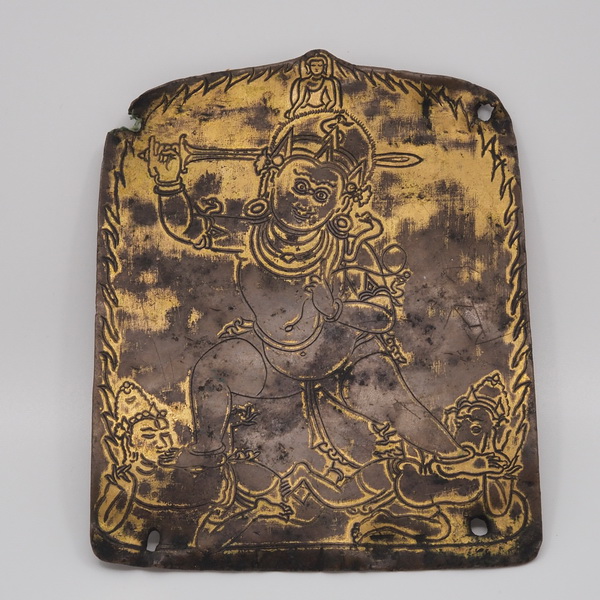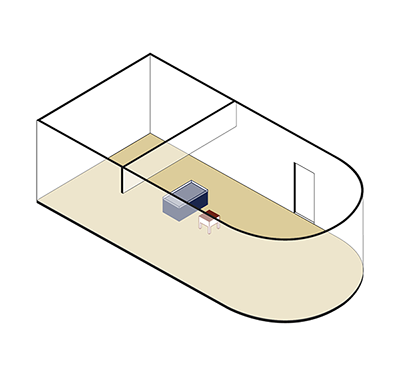ABS 329
Code: ABS 329
Country: Tibet
Style: Late Pala Style
Date: 1100 - 1200
Dimensions in cm WxHxD: 9.5 x 11.5
Materials: engraved gilt copper sheet
One of the Protector Deities of Vajrayana Buddhism
Gilt copper sheet engraved.
The fearful form of Nila Acala or “blue Acala” (Tib.: Mi g.yo ba sngon po) is trampling on the defeated Hindu gods Siva and Ganesa. Acala is stepping to the right with the right leg bent and the left straight (pratyalidhasana). He brandishes in the right uplifted hand the sword (khadga) as symbol of “cutting through ignorance”, and holds with the left hand, displayed in the gesture of exorcism (karana-mudra) with the index finger and small finger erect, the noose (pasa), an attribute of mainly wrathful deities to catch the enemies of Buddhism. Acala is sparsely dressed with an animal skin tied around the belly. The crown, the ornaments at the upper arms, the “investiture with the sacred thread” (nagopavita), the anklets and the belt are composed of snake emblems. Note the small effigy of Aksobhya above the crown.
The name Acala means “mountain” or literally “immovable”, and he is always shown in fearsome attitude and represents one of the ten Khroda protector deities in various Mandalas.
The Sadhanamala (SM), Nispannayogavali (NSP), Kriyasamgraha (KS), and the Pindikrama-Sadhana (PKS) contain sadhanas of several forms of Acala (Tib.: Mi g.yo ba), all described as squint-eyed: SM 85-88, 211-12; NSP 1-3, ll, 20, 26; KS 2; PKS 175-78.
Acala is known in Sanskrit literature under various names, such as Candacala, Candamaharosana, Mahacandarosana (SM 85-88), Kekara (SM 212), or Vajrabhisana (NSP 11, KS 2). Acala can be shown with one face and two arms
(SM 85-88, 211-12, KS 2); one face and six arms (NSP 3); three faces and four arms (NSP 11); and three faces and six arms (NSP 1, 2, 20, 26, PKS 177).
The Tibetan iconographic compendiums distinguish between Nila-Acala or “blue Acala” (Tib.: Mi g.yo ba sngon po), Rakta-Acala or “red Acala” (Tib.: Mi g.yo ba dmar po), and Sita-Acala or “white Acala” (T ib.: Mi g.yo ba dkar po). The Narthang Pantheon of the bKa’ gdams order, based on the teachings of Atisa (982-1054), illustrates six forms of Acala (CBI 862-687). Sculptures
and paintings of Acala depict him mostly with three eyes, but sometimes only with two eyes. The squinting eyes are one of the characteristics of Acala.
(Formerly: Collection Heidi & Ulrich von Schroeder; 2012-15)
Also known as Acalanatha, Aryacalanatha, Acala-vidya-raja and Candamaharosana. In Vajrayana Buddhism, Acala (alternatively, Achala or Acala) is the best known of the Five Wisdom Kings of the Womb Realm. Acala means "The Immovable One" in Sanskrit. Acala is also the name of the eighth of the ten stages of the path to buddhahood.
Acala is the destroyer of delusion and the protector of Buddhism. His immovability refers to his ability to remain unmoved by carnal temptations. Despite his fearsome appearance, his role is to aid all beings by showing them the teachings of the Buddha, leading them into self-control.
He is seen as a protector and aide in attaining goals. Temples dedicated to Acala perform a periodic fire ritual in devotion to him.
The buddha Akshobhya, whose name also means “the immovable one”, is sometimes merged with Acala. However, Acala is not a buddha, but one of the Five Wisdom Kings of the Womb Realm in Vajrayana as found in the Indo-Tibetan tradition, as well as the Japanese Shingon sect of Buddhism. As 'Fudo myo-o', Acala is considered one of the Thirteen Buddhas in Japan
Iconography
Acala is typically depicted with a sword for subduing demons in his right hand and a rope for catching and binding them in his left hand. He has a fearsome blue visage and is surrounded by flames, representing the purification of the mind. He is often depicted seated or standing on a rock to show his immovability. His hair commonly has seven knots and is draped on his left side, a servant hairstyle in Buddhist iconography. He is frequently depicted with two protruding fangs. One tooth points down, representing his compassion to the world, and one tooth points up, representing his passion for truth.
Béguin, Gilles, 2013. Art sacré du Tibet – Collection Alain Bordier, [catalogue of the exhibition held at the Fondation Pierre Bergé – Yves Saint Laurent; 14 mars au 21 juillet 2013]. Paris: Fondation Pierre Bergé – Yves Saint Laurent. Editions Findakli.
Chandra, Lokesh, 1991. Buddhist Iconography of Tibet (CBIT). New Delhi: International Academy of Indian Culture & Aditya Prakashan. Nos. 13, 187, 202, 322 of the Mongolian bKa ’gyur [1-510]; nos. 682-687, 775, 934-935 of the Narthang Pantheon [511-1009]; nos. 2377 (174) and 2422 (219) of the Three Hundred Icons (sKu brnyan sum brgya) [2204-2503]
de Mallmann, Marie-Thérèse, 1963. “Notes d’iconographie tântrique: III. A propos du Fudô bleu [Acala]”, Arts Asiatiques. Tome IX, Fasc. 1–2. EFEO, Musée Guimet. Pp. 73-79. fig. 1
de Mallmann, Marie-Thérèse, 1964. Étude iconographique sur Manjusri. Paris: École Française d’Extrème-Orient. Pp. 16, 30, 32, 70-71, 111-12, 128-32
de Mallmann, Marie-Thérèse, 1975. Introduction à l'iconographie du tântrisme bouddhique. Paris: Adrien Mainsonneuve (Jean Maisonneuve successeur (1970). Pp. 83-85
Georges, Christopher, 1974. The Candamaharogana Tantra. A Critical Edition and English Translation. American Oriental Series, vol. . New Haven: American Oriental Series.
Heller, Amy, 1999. Tibetan Art Tracing the Development of Spiritual Ideals and Art in Tibet 600-2000 A.D.. Jaca Books.
Huntington, John C.; Bangdel, Dina und Arvidsson, Björn (Traduction), 2010. Le Cercle de la Félicité. Art Méditatif Bhouddhique. «The cercle of Bliss. Buddhist meditational Art».. Genève: Duo Visual.


